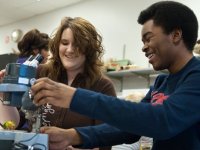PBL Meets the Next Gen Science Standards
Although the Next Generation Science Standards (NGSS) have not yet been fully implemented, more and more states are signing up as early adopters. The NGSS call for a conceptual shift in teaching and learning. Along with traditional subject matter, science and engineering are now integrated into the standards, and students will learn about the principles of engineering and engage in the engineering design processes.
In addition, many concepts are cutting across content. For example, the concept of "systems and system models" is used in the exploration of nuclear energies as well as ecosystems. Also, scientific and engineering practices are aligned multiple times with the disciplinary content. The NGSS calls for a deeper understanding and application of content. The focus is on core ideas and practices of science, not just the facts associated with them. This is a great opportunity for project-based learning, because not only can PBL align to the shift in pedagogy, it can also enhance what the NGSS demand.
The Alignment
Just as the draft NGSS calls for deeper understanding and application of knowledge, PBL demands the same -- in-depth inquiry into the content. When teachers design PBL projects, they choose to focus on power standards, or standards that usually take significant time to teach and focus on depth, not breadth. The NGSS will be a similar kind of standards, and thus easily used when designing PBL. In fact, a teacher designing a PBL project might target one of the crosscutting concepts, something that permeates the entire year of content. This is no more evident than the NGSS App available on iTunes. Take a look at the Grade Four Earth Systems Standard:
This standard focuses on explanation of changes -- not just identifying them, but using them to think critically about the content. In fact, the NGSS app provides an "Assessment Boundary" that says: "Assessment does not include specific knowledge of the mechanism of rock formation or the memorization of specific rock formations and layers." This is about depth, not rote memorization, which is ripe for a PBL project. In fact, the clarification statement of this standard highlights possibilities for a PBL project:
Being a Scientist
Most state science standards were linked to the scientific inquiry process. The NGSS continue to honor this as a key component to science education. Dimension 1 of the NGSS focuses on practices which "describe behaviors that scientists engage in as they investigate and build models and theories about the natural world and the key set of engineering practices that engineers use as they design and build models and systems." Embedded throughout standards is language where students must "use evidence," "make observations," "ask questions," "combine information," and "apply scientific ideas," to name just a few. All of this language focuses on the art of being a scientist to learn the content. PBL calls for students not only to be scientists, but also citizen scientists investigating real-world scientific problems and challenges to make an impact. Like the NGSS, PBL focuses not only on the content of science, but also on the content of being a scientist.
STEAM PBL
I wrote about this in a recent blog. As we notice the new engineering focus of NGSS, we might consider design challenges, a key component of science, technology, engineering, art, and mathematics (STEAM) education. However, design challenges are not necessarily PBL by default. One can take a design challenge, add some PBL-essential elements to it, and make it into a PBL project, yet there are some components that must be added to make it a true PBL project. In the example from my previous blog, students made recommendations for retrofitting a local bridge and presented this information to city officials and engineers. Yes, the product might be a bridge design, and yes, students might engage in a toothpick contest along the way. The difference is that the work goes outside the four walls of the classroom and is actually an authentic situation where students are engaged in real-world work. As the design process and other components of engineering are leveraged in the NGSS, PBL projects can be designed to teach and assess these standards.
The NGSS will be successful only if we give students the learning models that call for the rigor and depth they demand. Not only is PBL ready for the challenge, but it can create deeper engagement with the content, where students' deeper learning in the classroom makes them real scientists and engineers of the real world.
